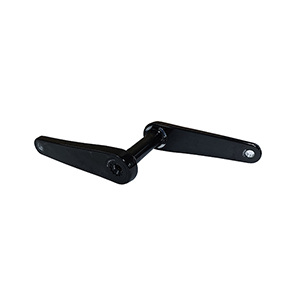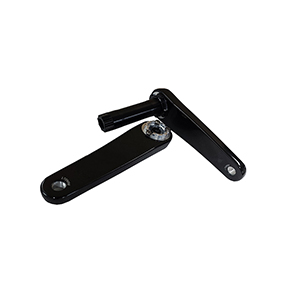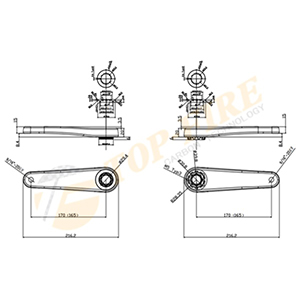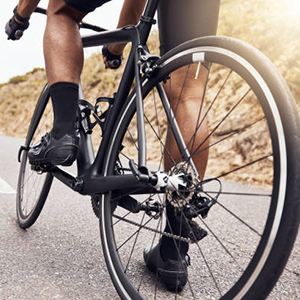
Carbon Cranks vs Aluminum
When it comes to bikes, every part plays a role in how the ride feels. One part that riders often overlook is the crank, the arms that connect the pedals to the bottom bracket. Cranks may look simple, but the material and size can change how efficient, strong, and comfortable a bike feels.
In today’s cycling world, the big debate is between carbon cranks and aluminum cranks. Carbon fiber cranks are praised for being lighter and stiffer, while aluminum cranks are known for their strength and reliability. Riders who care about weight savings often lean toward carbon, while those who want durability without spending too much usually pick aluminum.
But the choice isn’t only about weight or price. The crank you pick can affect how power transfers to the pedals, how your legs feel after long climbs, and even how your bike holds up over years of riding. In this guide, we’ll compare carbon cranks vs aluminum, look at how crank length matters, and share tips that make it easier to decide.
What Are Carbon Bike Cranks and Why Do They Matter?
Carbon bike cranks are crank arms made from carbon fiber, a material known for being both strong and lightweight. Its material grades include T700/T800/T1000. They connect your pedals to the chainrings, turning the energy from each pedal stroke into forward motion. While they may look like a small part of the bike, cranks play a key role in how efficient and comfortable your ride feels.

Here’s Why They Matter:
Power transfer: A solid crank helps you push more of your energy into the drivetrain.
Weight savings: Carbon is lighter than aluminum, which can make climbing and acceleration feel easier.
Riding feel: The stiffness of carbon can change how responsive your bike feels on the road or trail.
Choosing the right crankset isn’t just about looks—it can shape your entire riding experience.
Carbon Cranks: Key Advantages and Drawbacks
Carbon fiber cranks are often chosen by riders who want to save weight and get a more responsive ride. They’re made from carbon fiber, which makes them lighter than most aluminum options and often stiffer, too. This can make climbing and sprinting feel smoother since less energy is lost in each pedal stroke. Many road cyclists and racers see them as a performance upgrade.
But carbon cranks also come with trade-offs:
Advantages:
Lighter weight compared to aluminum.
High stiffness for efficient power transfer.
Modern designs with sleek looks.

Aluminum Cranks Strengths and Limitations
Aluminum cranks have been a standard choice for decades, and for good reason. They are strong, affordable, and widely available. Many riders appreciate their durability since aluminum can handle bumps, drops, and daily use without much worry. For those who ride in rough conditions or just want a reliable option, aluminum is often the go-to material.
That said, aluminum cranks do have their limits. While they are tough, they’re usually heavier than carbon, which may be noticeable during climbs or long rides. Over time, they can also flex more under heavy power, which may slightly reduce efficiency for some riders.
Strengths:
More affordable than carbon.
Durable and less prone to damage from impacts.
Easy to find and replace.
Limitations:
Heavier than carbon cranks.
Slightly less stiff under high loads.
Carbon Cranks vs Aluminum
When you’re deciding between carbon and aluminum cranks, it helps to see the differences side by side.
|
Feature |
Carbon Cranks |
Aluminum Cranks |
|
Weight |
Much lighter, helps you climb and accelerate faster |
Heavier, but still fine for most riders |
|
Stiffness |
Very stiff, transfers more of your power into speed |
Can flex a little under heavy pedaling |
|
Durability |
Strong but can crack if hit hard |
Tough and better at handling impacts |
|
Cost |
More expensive, often a premium upgrade |
More budget-friendly and widely available |
|
Maintenance |
Harder to repair if damaged |
Easy to replace or service |
|
Best For |
You want light weight and performance gains |
You want reliability and value |
Which is better, a 170mm or a 175mm crank?
Crank length is one of those details that can change how your bike feels, even if you don’t notice it right away. The most common options are 170mm carbon cranks and 175mm carbon cranks. The number refers to the distance from the center of the bottom bracket to the center of the pedal hole. While the difference may look small, it can affect comfort, power, and pedaling style.
170mm Carbon Cranks:
Better for riders with shorter legs or smaller frames.
It can reduce knee strain because your pedal stroke isn’t as wide.
Often preferred by riders who spin at a higher cadence.

Which Riders Should Choose Carbon Bike Cranks?
Carbon fiber cranks are ideal if you care about weight, efficiency, and performance. They can make a noticeable difference in how your bike responds, especially during climbs or sprints. However, not every rider needs them. Here’s who benefits most:
Road Racers and Competitive Riders: You’ll enjoy lighter weight and better power transfer for long rides or races.
Climbers: Carbon cranks reduce rotating weight, making uphill sections feel easier.
Performance-Focused Cyclists: If you want your bike to feel more responsive, carbon cranks can enhance the riding experience.
If you ride casually or mostly commute, carbon cranks may be more than you really need. But if your goal is speed, efficiency, and a high-performance ride, choosing carbon cranks is a smart move.
Which Riders Should Choose Aluminum Cranks?
Aluminum cranks are a solid choice if you value durability, reliability, and affordability. They handle daily wear and tear well, making them suitable for many types of riders. Here’s who will benefit most:
Commuters and Casual Riders: Aluminum cranks provide strong performance without worrying about minor bumps or drops.
Mountain Bikers and Off-Road Riders: They can take hits from rocks, roots, and rough trails without damage.
Budget-Conscious Cyclists: If you want a dependable crankset without spending too much, aluminum is a smart option.
If your main goal is high-speed racing or reducing every possible gram, carbon might be better. But for everyday riding, durability, and value, aluminum cranks often make the most sense.
Do Better Carbon Bike Cranks Make a Difference?
Upgrading your cranks can feel like a small change, but it can impact your ride in ways you might notice. High-quality carbon cranks are designed for performance, but the benefits depend on your riding style.
Weight Matters
Carbon cranks are lighter than aluminum. You’ll feel the difference when climbing hills or accelerating. Less weight means your legs don’t have to work as hard for each pedal stroke.
Power Transfer
Stiff carbon fiber cranks help transfer more of your energy to the drivetrain. This makes your pedaling more efficient and can improve speed, especially during sprints.
Riding Feel
Better carbon bike cranks can make the bike feel more responsive. You may notice smoother pedaling and less flex in the crank arms.
When It Makes the Biggest Difference
If you ride competitively or tackle challenging climbs, upgrading to a high-end carbon crankset can improve performance. For casual rides or commuting, the change may be less noticeable, but you’ll still enjoy a lighter and slightly more responsive ride.

Expert Tips for Choosing the Right Cranks
Picking the right crankset can make your rides more comfortable and efficient. Here are some expert tips to help you decide.
Consider Your Riding Style
Think about where and how you ride most. If you do long road rides or races, lighter carbon cranks may improve performance. For off-road or mountain biking, aluminum cranks offer durability and strength.
Match Your Crank Length
Crank length affects pedaling comfort and efficiency. Shorter cranks (like 170mm) can reduce knee strain and suit smaller riders. Longer cranks (like 175mm) give more leverage for climbing or powerful pedaling.
Balance Budget and Performance
High-end carbon cranks are great for performance, but they cost more. Aluminum cranks are more affordable and reliable for everyday use. Think about what fits your budget while still meeting your needs.
Check Compatibility
Make sure your crankset works with your bottom bracket and chainrings. Using the correct crank ensures smooth pedaling and reduces wear on your drivetrain.
Test If Possible
If you can, try different cranks. Feeling how they pedal on your own bike is the best way to know what suits you.
By considering your riding style, crank length, budget, and compatibility, you’ll make a choice that improves your ride and keeps you comfortable on every journey.
Conclusion
Choosing the right crankset can have a noticeable impact on your cycling experience. Carbon cranks are lighter and stiffer, making them ideal if you want speed, efficiency, and performance gains. Aluminum cranks, on the other hand, are durable, affordable, and well-suited for everyday riding or rough conditions.
When deciding, consider your riding style, crank length, and how much you value performance versus durability. Competitive riders or climbers may notice bigger benefits from carbon cranks, while casual riders often get reliable performance from aluminum.
Ultimately, the best crankset is the one that matches your body, your bike, and your goals. Paying attention to these details ensures a more comfortable, efficient, and enjoyable ride every time you hit the road or trail.
Categories
New Blog
Copyright © 2025 Top-Fire Carbon Technology Co., Ltd. All Rights Reserved. Power by

IPv6 network supported